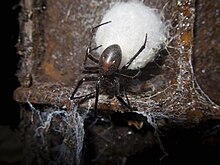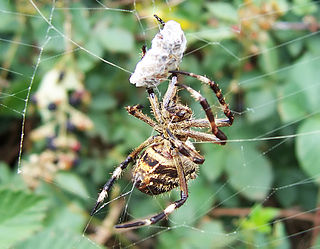
The Australian garden orb weaver spider is a very common species of spider with many variants in size, shape, and colour across the coastal and northern regions of Australia. They have very large abdomens when well-fed and exhibit a tremendous colour-range from off-white through tan, brown to almost black. They have a roughly leaf-shaped pattern on the top of their abdomen with a complex outline that is darker than the surrounding area. There may also be several whitish spots or one or more stripes. The spiders' cephalothoraxes (heads) and proximal leg segments are usually darker, mostly reddish or reddish brown. They are able to change their colour with each moult to better match the background upon which they rest during the day.

The Mediterranean recluse spider is a species of spider that originated in the Mediterranean region as its name implies, but can now be found in many parts of the world and is listed as one of the most invasive spiders worldwide. Usually dwelling in caves, the spiders will also inhabit basements and tunnels. Their webs shelter their egg sacs, which hatch into young that molt as they grow. The spider hunts at night and eats species including silverfish and cockroaches, and they usually target smaller insects.

Meta is a genus of long-jawed orb-weavers that was first described by Ludwig Carl Christian Koch in 1835. They are often associated with caves, caverns, and recesses, earning some of them the name "cave orbweavers"

Nephila pilipes is a species of golden orb-web spider. It resides all over countries in East and Southeast Asia as well as Oceania. It is commonly found in primary and secondary forests and gardens. Females are large and grow to a body size of 30–50 mm, with males growing to 5–6 mm. It is the second largest of the orb-weaving spiders apart from the recently discovered Nephila komaci. The first, second, and fourth pairs of legs of juvenile females have dense hairy brushes, but these brushes disappear as the spider matures.
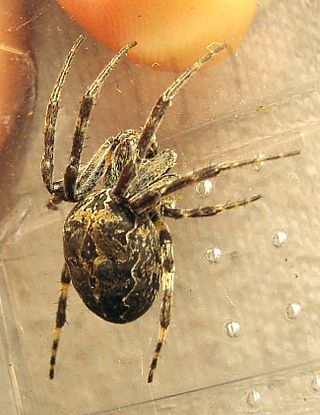
Larinioides sclopetarius, commonly called bridge-spider or gray cross-spider, is a relatively large orb-weaver spider with Holarctic distribution. These spiders originated in Europe, have been observed as south as the Mediterranean Coast and as north as Finland, and have been introduced to North America. They are often found on bridges, especially near light and over water. The species tends to live on steel objects and is seldom seen on vegetation. Females reach a body length of 10–14mm, and males 8–9mm. Their orb webs can have diameters of up to 70 cm.

Larinioides cornutus, the furrow spider, furrow orb spider, or foliate spider is an orb-weaver spider with Holarctic distribution.
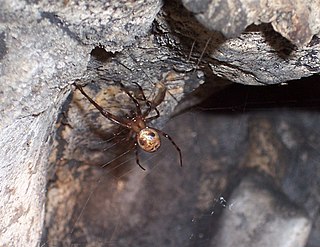
Meta menardi, the European cave spider, is a long-jawed orb-weaving spider. It is also known as the orbweaving cave spider, the cave orbweaver and, in context, simply the cave spider.

Gasteracantha cancriformis is a species of orb-weaver spider. It is widely distributed in the New World.

Dolomedes aquaticus is a fishing spider that lives and hunts along the gravel banks of unforested New Zealand rivers. It prefers open riverbanks where it lives under rocks, usually less than 5 metres from the river. Its colouring allows it to blend in with river stones. Normally nocturnal, it sits and waits for its prey after dark, and can survive for short periods under the water.
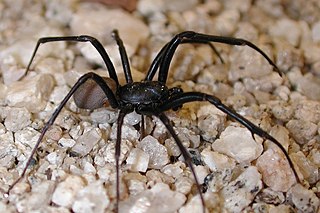
Plectreuridae, also called plectreurid spiders, is a small spider family confined to the Southwestern United States, Mexico, and the Caribbean. Only two living genera are known—the nominate genus Plectreurys and Kibramoa. In the past, the family was more widespread, with the Jurassic genus Eoplectreurys known from China, the Eocene Palaeoplectreurys baltica from Baltic amber and the Miocene Plectreurys pittfieldi from Dominican amber.

Darwin's bark spider is an orb-weaver spider that produces the largest known orb webs, ranging from 900 to 28,000 square centimetres, with bridge lines spanning up to 25 metres (82 ft). The spider was discovered in Madagascar in the Andasibe-Mantadia National Park in 2009. Its silk is the toughest biological material ever studied. Its tensile strength is 1.6 GPa. The species was named in honour of the naturalist Charles Darwin on November 24, 2009—precisely 150 years after the publication of The Origin of Species.
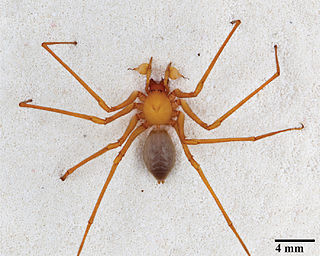
Trogloraptor is a genus of large spiders found in the caves of southwestern Oregon. It is the sole genus in the family Trogloraptoridae, and includes only one species, Trogloraptor marchingtoni. These spiders are predominantly yellow-brown in color with a maximum leg span of 3 in (7.6 cm). They are remarkable for having hook-like claws on the raptorial last segments of their legs.
Pimoa rupicola is a species of the spiders family Pimoidae found in France and Italy. First described in 1884, it is one of twenty-eight described species in the genus Pimoa.
Troglohyphantes vignai is a species of cave spider of the family Linyphiidae. It is endemic to Italy.
Troglohyphantes nigraerosae is a species of cave spider of the family Linyphiidae. It is endemic to Italy.

Tetragnatha montana, commonly known as the silver stretch spider, is a species of long-jawed orb weaver from the family Tetragnathidae that has a Palearctic distribution. It preys mostly on flies and mosquitoes. The name silver stretch spider refers to its shiny metallic colour and its habit of extending its legs into a stick like shape.
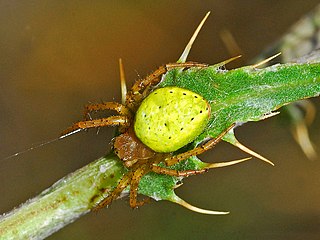
Araniella opisthographa is a species of orb weaver in the spider family Araneidae.

Stalita taenaria is an araneomorph spider species in the family Dysderidae. The species is classified as a member of troglofauna, more precisely a troglobiont species, meaning such spiders are obligate cave-dwellers adapted to living in dark surroundings. Stalita taenaria is a species of a few European countries. The spider is thought to be the first described species of true (eyeless) cave spider in the world.
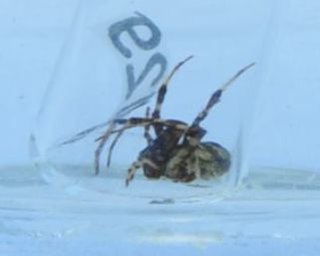
Gea eff is a species of orb-weaver spider. It is found in Papua New Guinea. The arachnologist Herbert Walter Levi formally described the species in 1983. While it was still undescribed, Michael H. Robinson and colleagues reported on its courtship and mating behaviors. Gea eff has the shortest scientific name of any spider species.

Salsa is an Australasian genus of orb-weaver spiders.
